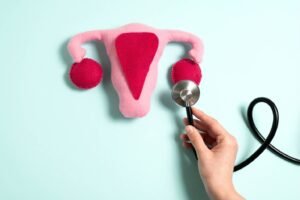Best Hospital for Endometrial Polyp Treatment
Endometrial or uterine polyps are very common in reproductive-age women and are one of the most common causes of abnormal uterine bleeding between periods. These polyps are an overgrowth of the uterus’s inside lining called the endometrium. Although endometrial polyps are almost always benign, they can be premalignant or malignant. Endometrial polyp treatment is done by removing it, and it is tested to review and ensure that it is benign.
Polyps can be present in the uterus without any abnormal uterine bleeding. Therefore, it is not uncommon for polyps to be incidental findings during an investigation for infertility. One of the common diagnostic tests for infertility is hysterosalpingography (HSG: x-ray of the uterus and fallopian tubes).

Endometrial Polyps and Infertility
Being associated with infertility, at least one good study revealed that removing the polyp increases the chances of conceiving. The study found that when a polyp was removed, the pregnancy rate was 63%.
Another study found that the most common area in the uterus for an endometrial polyp to be found was on the posterior uterine wall. Interestingly, polyps found in the corneal portion of the uterus (the area of the opening of the fallopian tubes into the uterus) were associated with a higher chance of pregnancy when these polyps were removed compared to removing polyps from other locations within the uterus. This suggests that polyps in this location are more likely to be associated with difficulty in conceiving.
It has been speculated that it may may irritate the uterus lining, interfering with embryo implantation. These polyps can interfere with implantation, effectively preventing an embryo from attaching to the uterine wall. It is common for polyps to induce a chronic inflammatory response within the uterus as the body mounts a reaction to try to destroy the polyp. This may be the mechanism by which polyps interfere with the establishment of a pregnancy.
If an abnormality in the uterus is discovered during fertility investigation, it is recommended that the woman should undergo a hysteroscopy to remove the abnormality.

Endometrial Polyp Treatment and Diagnosis
HSGs or hysterosalpingography are performed to determine if the fallopian tubes are open. A dye is injected into the uterus and passes into the fallopian tubes. Therefore, an image of the uterus is obtained to determine whether the tubes are open. Then the Uterus image could reveal abnormalities (Typically, these abnormalities are polyps, fibroids, adhesions, or a uterine septum) within the uterus.
Another diagnostic test is a vaginal sonogram screening. When this is performed in the mid-portion of a menstrual cycle (time of ovulation), then abnormalities of the endometrium may be discovered. Contact Ayaansh Hospital is one of the Best IVF centers in Bangalore, providing world-class fertility treatments and best endometrial polyp treatment.

Removal of the endometrial polyp
Removal of those abnormalities by hysteroscopy is done using a small scope that is passed through the cervix into the intrauterine cavity so that the inside of the uterus can be visualized directly.
An anesthetic is given to avoid any discomfort from the procedure. Direct visualization can remove a polyp without disturbing the rest of the endometrium. Before hysteroscopy, the polyps were removed by “blind” D&C. A D&C involves scraping the entire lining of the uterus, expecting that the polyp will be removed with the procedure. A blind D&C should be avoided as there is always a risk of creating scar tissue in the uterus from the procedure.
The hysteroscopic removal of an endometrial polyp usually takes less than one hour to complete. Patients are asked to rest a day after the surgery because of the anesthetic sedation. However, patients can return to work the following day. Contact Ayaansh Hospital, one of the Best IVF centers in Bangalore. We specialize in low-drug infertility solutions that help women conceive with minimal invasiveness and a high success rate.


